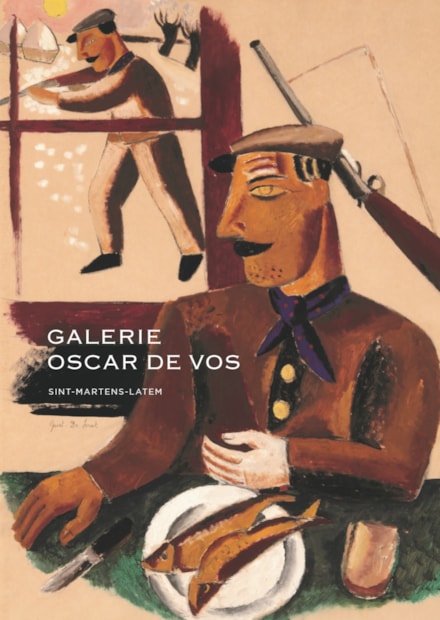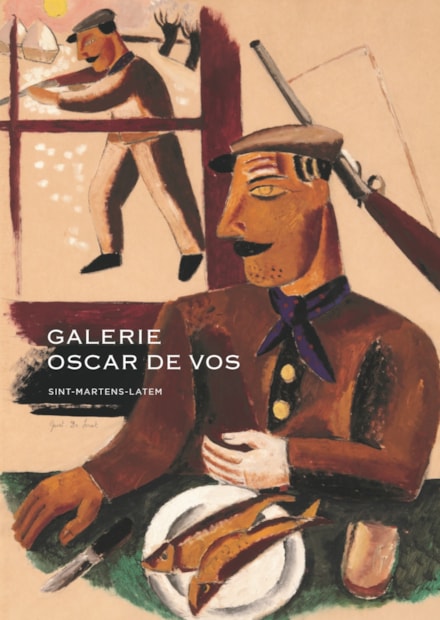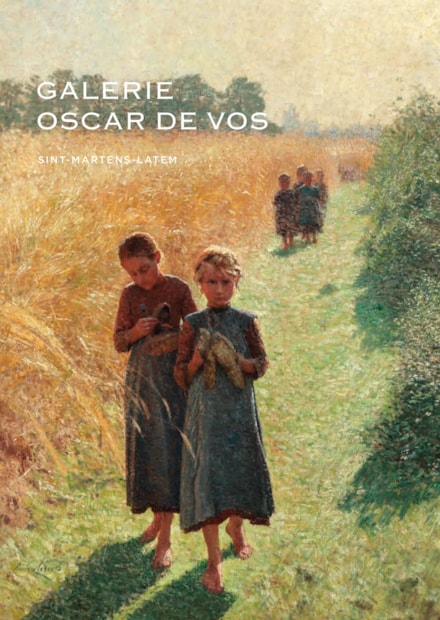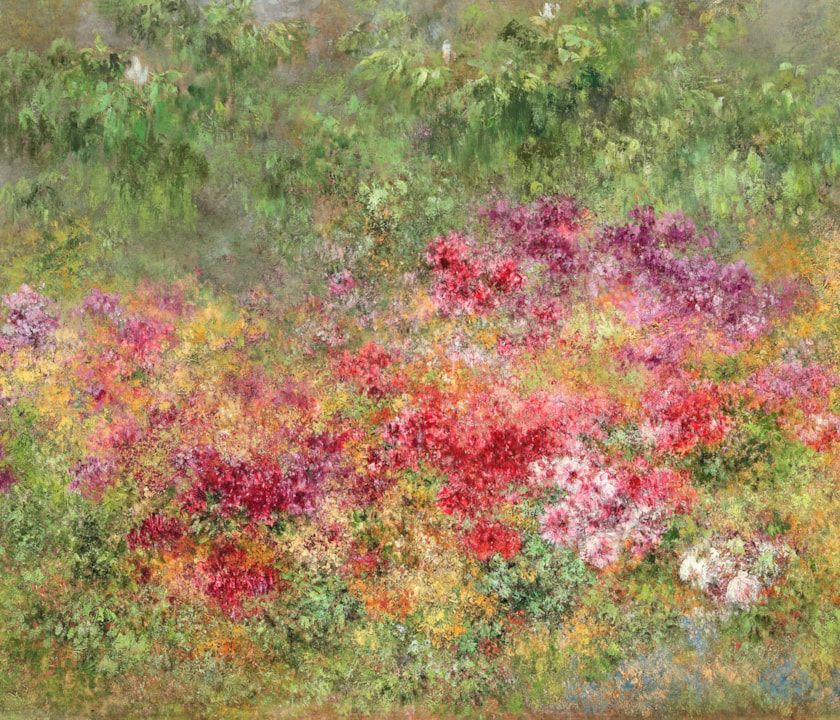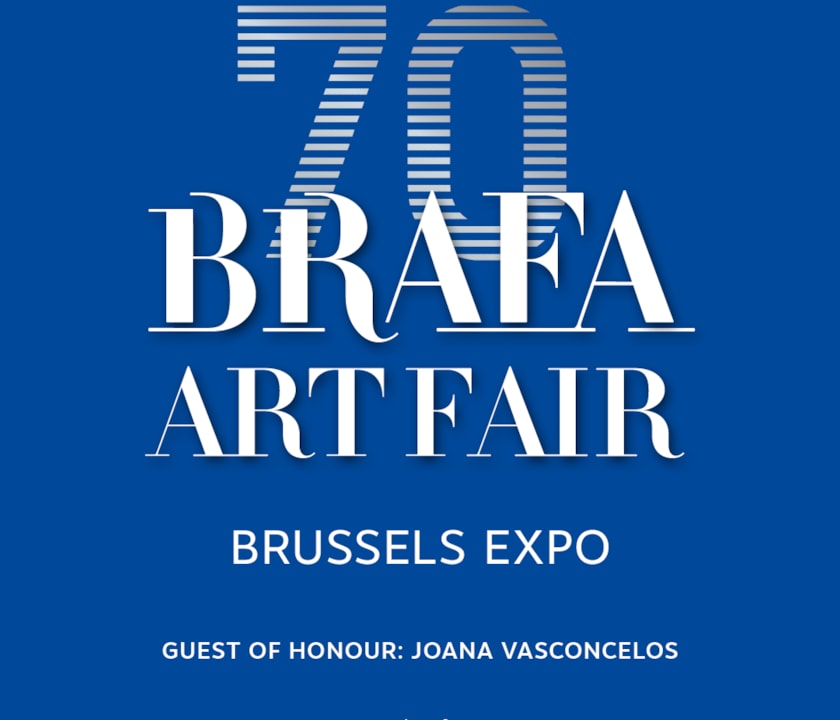Constant Permeke
(1886 - 1952)

Constant Permeke
(1886 - 1952)
Un curieux jeu du destin a voulu que le quartier du Patershol joue à plusieurs reprises un rôle décisif dans le développement de l’art pictural dans la région de la Lys. Dans les années 1890, le quartier était le lieu de rencontre des principaux membres de ce que l’on a appelé le premier groupe de Laethem: Minne, Van de Woestyne, De Saedeleer, De Praetere. En 1906, l’histoire semble se répéter. Cette année-là, dans ce même quartier, sont jetés les fondements du deuxième groupe: les étudiants d’académie Permeke, De Smet et Van den Berghe y échangent leurs réflexions et y bâtissent leur avenir.
Les années de jeunesse de Constant Permeke à Anvers sont insignifiantes. Mais son univers est profondément bouleversé par son déménagement à Ostende en 1891. Son père, Henri-Louis, y a été nommé conservateur du Musée des Beaux-Arts local et, avec James Ensor, il joue un rôle important dans la vie artistique de la ville. Lors des expositions que tous deux organisent dans la ville, Constant Permeke est pour la première fois confronté à l’art moderne.
Il reçoit sa première formation à l’académie de Bruges, mais c’est seulement lors de ses années gantoises vers 1906 que son talent éclate. Albert Servaes est un de ses condisciples à l’académie de Gand et a sur Permeke une influence particulière. À cette époque, il se lie également d’amitié avec les frères Gustave et Leon De Smet, Frits Van den Berghe et Paul-Gustave van Hecke, ce dernier se faisant très vite un nom comme critique d’art.
Au printemps 1909, il s’installe à Laethem-Saint-Martin où il va habiter près de chez son ami Gustave De Smet et où il retrouve également ses amis Van Hecke et Van den Berghe. Le contact avec Albert Servaes est d’une grande importance artistique. Il expose d’ailleurs avec celui-ci en 1913 au Cercle Artistique et Littéraire de Gand. Après son mariage en 1912, Permeke s’en retourne à Ostende où il devient le voisin de Leon Spilliaert.
Au début de la Première Guerre Mondiale, Permeke est gravement blessé et est transféré à Londres. Pendant sa convalescence, il réside d’abord à Stanton Saint-Bernard et ensuite à Chardstock.
Permeke revient en Belgique au printemps 1919. Bien qu’il fasse partie du cercle gravitant autour des galeries bruxelloises Sélection et Le Centaure, l’artiste garde cependant une certaine distance. Contrairement à ses amis Gustave De Smet et Frits Van den Berghe, il n’entretiendra jamais de contacts permanents avec ces marchands d’art.
En 1929-1930, il s’installe dans une maison-atelier à Jabbeke, ‘De Vier Winden’. Peu à peu, son travail connaît aussi un retentissement international. Ainsi, le marchand d’art amstellodamois Buffa organise des expositions personnelles presque chaque année à partir de 1925 et jusqu’en 1945. Comme ses amis Gustave De Smet et Frits Van den Berghe, Permeke fait aussi impression à l’exposition d’art belge à Grenoble en 1927; deux ans plus tard, il fait sensation à New York, Washington et Chicago. Cette même année, ses expositions individuelles aux Galeries bruxellois Le Centaure et Louis Manteau ont un écho international. Le triomphe suit lorsqu’en 1930, le Palais des Beaux-Arts de Bruxelles présente pas moins de 600 de ses œuvres. Vers 1930, Permeke entre en contact avec le peintre français Maurice De Vlaminck. Le Français sera à maintes reprises invité à Jabbeke.
Les années de crise semblent avoir peu de prise sur Permeke. Les expositions prestigieuses se succèdent et il jouit d’une célébrité internationale. Il reçoit un soutien financier du mécène bruxellois Gustave van Geluwe. L’État Belge lui offre même en 1935 le titre de baron, distinction qu’il s’empresse de refuser.
Il passe les années de guerre principalement à Bruxelles; Jabbeke se trouve dans la zone côtière où l’on a peu de liberté de mouvement. Il refuse énergiquement de participer à des expositions organisées par l’occupant. En conséquence, son exposition à la galerie Breughel en 1941 est classée ‘entartet’, (‘méprisable’), par les Allemands. Son engagement pour la galerie bruxelloise Apollo, qui navigue ostensiblement à contre-courant, est à cet égard exemplaire.
Le point culminant se situe en 1947, lorsque l’on peut découvrir de grandes rétrospectives de son travail à Amsterdam, Bruxelles, Prague et Paris. Les années suivantes, il domine également le pavillon belge à la biennale de Venise et à São Paulo. En 1951 encore, l’association anversoise “Art d’Aujourd’hui” honore l’artiste avec une imposante exposition rétrospective.
Constant Permeke décède le 4 janvier 1952 à la Clinique du Sacré-Cœur à Ostende.
Les années de jeunesse de Constant Permeke à Anvers sont insignifiantes. Mais son univers est profondément bouleversé par son déménagement à Ostende en 1891. Son père, Henri-Louis, y a été nommé conservateur du Musée des Beaux-Arts local et, avec James Ensor, il joue un rôle important dans la vie artistique de la ville. Lors des expositions que tous deux organisent dans la ville, Constant Permeke est pour la première fois confronté à l’art moderne.
Il reçoit sa première formation à l’académie de Bruges, mais c’est seulement lors de ses années gantoises vers 1906 que son talent éclate. Albert Servaes est un de ses condisciples à l’académie de Gand et a sur Permeke une influence particulière. À cette époque, il se lie également d’amitié avec les frères Gustave et Leon De Smet, Frits Van den Berghe et Paul-Gustave van Hecke, ce dernier se faisant très vite un nom comme critique d’art.
Au printemps 1909, il s’installe à Laethem-Saint-Martin où il va habiter près de chez son ami Gustave De Smet et où il retrouve également ses amis Van Hecke et Van den Berghe. Le contact avec Albert Servaes est d’une grande importance artistique. Il expose d’ailleurs avec celui-ci en 1913 au Cercle Artistique et Littéraire de Gand. Après son mariage en 1912, Permeke s’en retourne à Ostende où il devient le voisin de Leon Spilliaert.
Au début de la Première Guerre Mondiale, Permeke est gravement blessé et est transféré à Londres. Pendant sa convalescence, il réside d’abord à Stanton Saint-Bernard et ensuite à Chardstock.
Permeke revient en Belgique au printemps 1919. Bien qu’il fasse partie du cercle gravitant autour des galeries bruxelloises Sélection et Le Centaure, l’artiste garde cependant une certaine distance. Contrairement à ses amis Gustave De Smet et Frits Van den Berghe, il n’entretiendra jamais de contacts permanents avec ces marchands d’art.
En 1929-1930, il s’installe dans une maison-atelier à Jabbeke, ‘De Vier Winden’. Peu à peu, son travail connaît aussi un retentissement international. Ainsi, le marchand d’art amstellodamois Buffa organise des expositions personnelles presque chaque année à partir de 1925 et jusqu’en 1945. Comme ses amis Gustave De Smet et Frits Van den Berghe, Permeke fait aussi impression à l’exposition d’art belge à Grenoble en 1927; deux ans plus tard, il fait sensation à New York, Washington et Chicago. Cette même année, ses expositions individuelles aux Galeries bruxellois Le Centaure et Louis Manteau ont un écho international. Le triomphe suit lorsqu’en 1930, le Palais des Beaux-Arts de Bruxelles présente pas moins de 600 de ses œuvres. Vers 1930, Permeke entre en contact avec le peintre français Maurice De Vlaminck. Le Français sera à maintes reprises invité à Jabbeke.
Les années de crise semblent avoir peu de prise sur Permeke. Les expositions prestigieuses se succèdent et il jouit d’une célébrité internationale. Il reçoit un soutien financier du mécène bruxellois Gustave van Geluwe. L’État Belge lui offre même en 1935 le titre de baron, distinction qu’il s’empresse de refuser.
Il passe les années de guerre principalement à Bruxelles; Jabbeke se trouve dans la zone côtière où l’on a peu de liberté de mouvement. Il refuse énergiquement de participer à des expositions organisées par l’occupant. En conséquence, son exposition à la galerie Breughel en 1941 est classée ‘entartet’, (‘méprisable’), par les Allemands. Son engagement pour la galerie bruxelloise Apollo, qui navigue ostensiblement à contre-courant, est à cet égard exemplaire.
Le point culminant se situe en 1947, lorsque l’on peut découvrir de grandes rétrospectives de son travail à Amsterdam, Bruxelles, Prague et Paris. Les années suivantes, il domine également le pavillon belge à la biennale de Venise et à São Paulo. En 1951 encore, l’association anversoise “Art d’Aujourd’hui” honore l’artiste avec une imposante exposition rétrospective.
Constant Permeke décède le 4 janvier 1952 à la Clinique du Sacré-Cœur à Ostende.
oeuvres
publications

_1.jpg?width=540&height=1000&quality=90&format=jpeg&mode=max)




